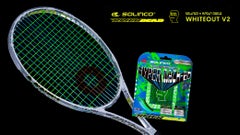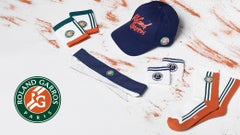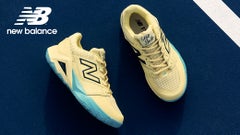Dunlop Muscle Weave 200g Racquet Review
The Max 200g may be Dunlop's most recognized racquet among over-30 tennis players. It's certainly their most "heritaged" graphite racquet. Dunlop can thank two players for that recognition - John McEnroe and Steffi Graf. Although these players had very different playing styles, they both dominated the game using the Max 200g. McEnroe, known for his net playing prowess, utilized short, compact strokes from the baseline. He was able to generate pace by stringing his racquets at very low tensions. His strength, however, wasn't overwhelming power, but pinpoint placement of shots that would allow him to come in and finish the point off at net. Steffi Graf, on the other hand, relied on a punishing baseline game, only coming to net when absolutely necessary or to shake hands at the end of a match. Despite their playing styles being so different, McEnroe and Graf dominated their respective tours using the Max 200g. While McEnroe contributed to the Max 200g's success, it wasn't his debut racquet like it was for Steffi. Who (in a certain age category...) doesn't remember when Fraulein Forehand burst onto the tennis scene, dashing around the red clay of Roland Garros and green lawns of Wimbledon on those spindly, colt-like legs, hammering her trademark loop forehand and pasting the lines? Those of us who have actually played with the Max 200g have an even greater admiration for her ability to generate so much power and precision with this racquet.
The Original 200g Specs: Weight: 12.5 ounces/355.4g, Balance: 8 points (1 inch) Head-light, Flex (RDC): 40, Swingweight: 337
The Dunlop Max 200g was the first graphite racquet to be constructed using injection molding. Typical racquet construction is done using compression molding, whereby sheets of graphite/epoxy are hand formed, placed into a mold and compressed at high temperatures. Injection molding, as performed by Dunlop for the Max 200g, combined two materials - carbon fiber (graphite) chips and nylon. Dunlop's proprietary name for this blend of materials was Grafil. During the injection molding process, the small graphite chips and nylon (Grafil) were combined, heated and injected into a mold to form the frame. The result was a racquet that was stiffer dynamically than statically. Rick Perry, Dunlop's Director of Research & Development offers, "the measure of resistance on the Max 200g is based on the rate pressure is applied. When pressure is applied at a slow rate, such as on a Babolat RA or RDC machine, the frame will seem very flexible. During fast swings, though, the frame deflects less and thus, returns more energy to the ball."
The Max 200g was a true player's racquet, even before this category was created. Although midplus and oversize racquets were available at the time, the Max 200g remained at 85 square inches. It was also one of the first "widebody" racquets, as a result of the injection molding process, measuring 22mm. However, this extra beam width didn't contribute much to frame stiffness, as evidenced by the RDC measurement.

In 1997, Dunlop resurrected the 200g moniker with the Revelation 200g Pro and Revelation 200g +1.00. While very different from its namesake, the Rev 200g became Dunlop's showcase player racquet and was used by most of their tour players, including Mark Philippoussis (Australian version), Wayne Ferreira, Tommy Haas, Cedric Pioline and Sjeng Schalken.
With the introduction of Dunlop's new Muscle Weave technology last year, the Rev 200g Pro and Rev 200g +1.00 have both been replaced by the Muscle Weave 200g 95. While it isn't the Max 200g, this descendant would make papa Max proud. It's a solid, albeit low-power, player's racquet and popular on the ATP Tour (as well as our demo program). All of the players listed above have switched to the Muscle Weave version (Cedric Pioline recently won the Monte Carlo Open using the Muscle Weave 200g 95). Dunlop also informed us that Amelie Mauresmo wielded a prototype Muscle Weave 200g 95 during her breakthrough run at the 1999 Australian Open, as did Tommy Haas. In addition to the midplus, Dunlop has added an oversize version of the Muscle Weave 200g, which we found to have very little in common with the midplus, save cosmetics. Here are our comments on both head sizes.
Muscle Weave 200g Midplus
From the baseline, the MW 200g 95 continues the tradition of its namesake by offering Max-imum control and minimal power. It offers full heft, medium flex and a dense string pattern, along with an elastomer/kevlar yoke in the throat to provide enhanced feel and comfort.. This combination tends to favor big hitters and string breakers. Granville offers, "this racquet is not for a beginner or someone just returning to the sport. Generating any significant power presents a challenge. I found that when I really 'hit out', I could get the response I'm accustomed to with my ProStaff 6.0 Mid, but only then. Good fundamentals are important for the player choosing this frame. However, if you're looking for a racquet that will allow you to hit topspin groundies with abandon, this racquet may be just right." Drew opines, "the MW 200g 95 seems to offer more flex than I recall the Revelation 200g having. The power level and extra flex lend themselves to hitting with more spin. For players who do hit with more spin, the dense string pattern will help extend string life. The MW 200g 95's stability enhances its comfort." Mark continues, "someone who likes to swing hard will probably love this racquet but passive, keep the ball in court players will have trouble keeping the ball deep. It has very little power, so you really have to swing hard to get good results.." Don comments, "watching players like Tommy Haas and Cedric Pioline makes one think this racquet has more than enough power. However, my swing just isn't big enough. The racquet's flex and, especially, the dense string pattern just didn't provide enough power for me. This racquet is definitely for players who consistently swing fast and hard. I can imagine this racquet performing better with 16 or 17 gauge natural gut - the extra power is welcome and the dense pattern reduces string wear."
At net, the MW 200g 95's stability is a noticeable asset, although power is still limited. Drew comments, "the racquet is maneuverable and stable on volleys. The touch is good but a firm wrist and good technique are required for pace - don't expect much if you're just blocking the ball back." Dan adds, "it's accurate and true but dead to the touch during off-center shots. I quickly learned to make sure volleys had some extra punch, which in the end, requires more racquet manipulation - not what I'm looking for or need up at net. I quickly learned to swing out on overheads or they'd just keep coming back." Granville counters, "this was a much more pleasing racquet at net, offering good maneuverability and touch. I could be aggressive and poach with confidence. The power issue is, of course, less of a factor at net but there was still that 'thud', instead of a 'thwap' when you know you've struck the ball well." Mark concurs, "while the MW 200g 95 wasn't a lot different from other player's racquets on volleys, it was a little more maneuverable and suprisingly stable on mis-hits. Solid overheads are possible but it takes good preparation and strength to really blast one."
Serving provided most playtesters with a little more power. Mark offers, "I was surprised at how much power I could generate on serves. The racquet has adequate mass but is also maneuverable enough to swing hard." Drew continues, "I felt the MW 200g 95 offered a little more power than the Revelation 200g 95 and this was most noticeable on serves, especially flat serves. I was able to really hammer flat serves, either up the middle or to the corners. I did have a little trouble controlling the depth of spin serves - perhaps it was the dense string pattern sometimes biting the ball and sometimes not." Dan agrees, adding, "no problem booming the big, flat serve up the middle. However, switching gears to slice or kick serves saw less impressive results. Once again, the dense string pattern just didn't allow me to get enough 'english' on the ball." Granville had a slightly different impression, commenting, "serving was consistent with groundstrokes. It was really difficult to get the ball moving. I could control the ball very well but without the sting of a more responsive frame, i.e., ProStaff 6.0, Precision Response Ti, Ti Radical). Most players probably won't enjoy those delicious aces or cheap points off serve return errors with this racquet."
The MW 200g 95 received high marks for touch shots, including drop shots, soft angle volleys and half-volleys. Mark explains, "this racquet has a lot of touch and not much power, so I was able to take a fuller, comfortable swing on finesse shots and not only keep the ball in the court but keep it where I was aiming. My favorite shot with the MW 200g 95 was the approach shot, especially off a kick second serve. I could generate good spin and could be very aggressive without the ball flying long." Dan adds, "there's no question that, in the right hands, this racquet will find a niche with players whose game relies heavily on touch and feel - from the back court and net. Half-volley angles and last minute drop shots were fun to hit with this racquet. The flexibility gave me confidence, while the dense stringbed provided a solid feel." Players used to blocking back serve returns may find the MW 200g too underpowered. Drew offers, "particularly on serve returns, blocked shots need to be hit firmly and in the sweetspot or they have trouble getting over the net. Aggressive returners, however, will like the control provided by this racquet. Dan concurs, "I found the flexibility to be a welcome element on serve returns. It required me to swing out off both wings, which I wasn't always able to do with more powerful racquets. I didn't have to hold back for fear of balls sailing."
It's clear to us that the Muscle Weave 200g 95 is designed for advanced, hard-hitting players. Lesser players will likely find this racquet too underpowered. However, for those who like to 'hit out' on every shot, and are seeking comfort and control in a traditionally weighted and balanced frame, the Muscle Weave 200g is worth a test drive.
Dunlop Muscle Weave 200g Midplus Technical & Statistical Data
(Scores are determined by averaging individual play test scores)
|
|
||||||||||||||||||||||||||||||||||||
Muscle Weave 200g 108
As stated earlier, the MW 200g 108 is not an oversized version of the MW 200g 95 and can't be categorized as a player's racquet. It's lighter, wider, longer and balanced head-heavy - really more of a game improvement racquet than a player's model. Having said that, the MW 200g 108 is a pretty solid racquet and features the same elastomer/kevlar yoke in the throat for added comfort.
From the baseline, the MW 200g 108 swings easy and provides adequate power for medium-swing players. Mark offers, "I really enjoyed the power, control, maneuverability and comfort of this racquet. I was able to hit heavy topspin or slice; slow, loopy topspin or hard flat shots. If I was pressured, I could either drive the ball or throw up a lob. In short, I felt comfortable hitting any shot I would normally hit in a given situation." Drew felt the MW 200g 108 offered less power than its appearance might suggest, adding, "the light weight and seemingly low sweetspot location contribute to a lower power level than I anticipated. Although the larger head offset the dense string pattern, I still found myself taking fairly large swings and hitting more spin on my groundstrokes. Slice shots had ample spin but weren't particularly penetrating. My consistency on all groundies was good but I found it hard to crack winners." Granville found the MW 200g 108 string tension sensitive. He explains, "strung too tight, it felt like a board, without enough mass behind the ball. Strung at the lower end of the tension range, the racquet seemed to perform better, providing good power, feel and larger sweetspot.. It's an exceptionally maneuverable racquet, making preparation much easier.." Don adds, "at 9.5 ounces, it's important not to string this racquet too tight. We playtested two different tensions and the lower tension was by far more appealing. I was able to take full swings on groundstrokes without the ball flying, as spin was easy to produce. The racquet was maneuverable, comfortable and offered more control than I expected."
The MW 200g 108's oversize head, 27.5-inch length and light weight make it fun to use at net - sort of a toned-down "big easy" type racquet. Mark comments, "I had a lot of success serving and volleying with this racquet. I was able to put away many first volleys, even though I was hitting them from the service line. If I didn't put away the first volley, it was easy enough to put the next shot away with either another volley or an overhead. In addition to having a good power level for my game, the MW 200g 108 was very nimble at net. I had no problem reacting to hard-hit balls." Don offers, "due to the light weight, it was necessary to keep a firm wrist. However, the large head and light weight make it possible to quickly set the racquet and let it do the work. No extra effort was required to hit put-away volleys. Overheads were fun - the racquet's light enough to prepare easily and powerful enough to hit winners." Drew agrees, adding, "the racquet has enough power that you can block volleys and still have good pace. Half-volleys were good - enough pace to get over the net but not so much to sail long."
Serving with the MW 200g 108 probably favors spinners over boomers, although it does deliver good power. Don offers, "it's easy to generate good racquet head speed but I found my spin serves more effective than big, flat ones up the middle. Spin and kick serves required a full swing though. Otherwise, the ball sat up and my opponent was able to hit an aggressive return." Drew adds, "the racquet favors spin serves - either kick or slice. It's not built for booming flat servers. You can get decent but not spectacular pace hitting low in the string bed." Granville concludes, "when serving with the MW 200g 108, you can really feel the racquet head accelerate to the ball. You can deliver either a spin serve wide or punch it up the line. Its maneuverability is perhaps its strongest asset."
Maneuverability also allows for good reaction shots with the MW 200g 108, whether at net or from the baseline. Block serve returns can be effective against big serves, although the power may be less than one might expect from an oversize racquet due to its light weight. Drew says, "there's good consistency on returns but getting enough pace to keep the pressure on a good serve and volleyer is tough." The MW 200g 108 offered surprising touch and feel for a game improvement racquet. Mark comments, "I was able to hit some good drop shots and touch volleys. While I had to be a little gentler on low balls because of the higher power level, I was still able to hit them aggressively."
There's no question, the Muscle Weave 200g 108 is a different category of racquet than its little brother. However, it's not a full-blown power racquet either, falling somewhere between a 'tweener and game improvement racquet. As a result, it has wider appeal than if it were simply an oversize version of the Muscle Weave 200g 95. Intermediate players with compact to medium swings are probably the best candidates for this racquet. However, we can imagine WTA Tour players using the Muscle Weave 200g 108 (albeit, customized) as easily as we can weekend warriors. The secret's in the stringing...
Dunlop Muscle Weave 200g Oversize Technical & Statistical Data
(Scores are determined by averaging individual play test scores)
|
|
||||||||||||||||||||||||||||||||||||
Playtester Profiles |
|
| Granville | 5.5 all-court player currently using a Wilson Pro Staff 6.0 85 |
| Dan | 5.5 all-court player currently using a Gamma Tradition 18 MP. |
| Mark | 5.5 serve & volleyer currently using a Prince Thunder Ultralite Titanium Oversize. |
| Don | 4.5-5.0 all-court player currently using a Yonex Ultimum RQ Ti 1700 MP. |
| Drew | 4.5-5.0 baseliner currently using a Wilson Pro Staff 6.0 85. |
Playtest racquets strung with Tecnifibre NRG2 17 at mid-range (60 pounds).
Review date: May, 2000. If you found this review interesting or have further questions or comments please contact us.
All content copyright 2000 Tennis Warehouse.








